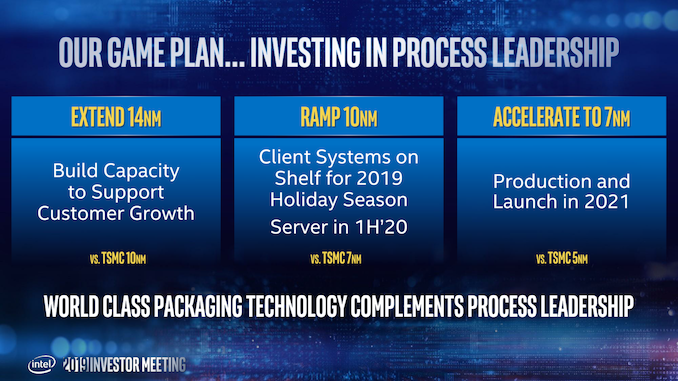Intel Process Technology Update: 10nm Server Products in 1H 2020, Accelerated 7nm in 2021
by Anton Shilov on May 8, 2019 3:29 PM EST- Posted in
- Semiconductors
- Intel
- 10nm
- EUV
- 7nm
- Manufacturing
Intel provided an update regarding its upcoming fabrication technologies at its 2019 Investor Meeting. The company is on track to produce server-class products using its 10 nm manufacturing technology already in the first half of 2020, which is something that the company implied on for a while now, but never confirmed officially. What is relatively surprising is that Intel intends to start production of ccommercial chips using its 7 nm process already in 2021.
Intel’s 7 nm production technology had been in development independently from the 10 nm process and by a different crew, so this one is closer than one might think. The node is set to use extreme ultraviolet lithography (EUVL) with laser wavelength of 13.5 nm for select layers, so it will not heavily rely on multipatterning, a major source of problems with Intel’s 10 nm process. In fact, the use of EUV will simplify development of products, make it easier to produce them, and will likely shorten production cycle times too.
The first product to use Intel's 7 nm process technology will be Intel's Xe-architecture-based GP-GPU in 2021. The GPU will not only be made using Intel’s most advanced node, but will also us Intel’s Intel’s Embedded Die Interconnect Bridge (EMIB) technology as well as Foveros silicon stacking technique, which confirms that the product is not a monolithic design.
Speaking of non-monolithic designs, it is noteworthy that Intel considers its innovative chip packaging technologies no less important than its new nodes, so expect things like EMIB and Foveros to be a big part of Intel's future.
While Intel's first 7 nm product will be launched in 2021, Intel stresses that high-volume manufacturing (HVM) using the technology will begin in 2022 when the technology will be used not only for a server GPU, but also a server CPU. So, expect more 7 nm products three or four years down the road.
Late last year Intel announced a major plan to upgrade a number of its fabs for next-generation process technologies. Officially, Intel is equipping its Fab 42 in Arizona to make chips using its 7 nm fabrication process. Meanwhile, given the scope of Intel’s upgrade plan, which includes fabs in Oregon, Ireland, and Israel, it looks like the company might have other fabs ready for 7 nm by 2021 - 2022 timeframe.
Meanwhile, as Intel intends to refine all of its fabrication processes in the same manner as it did with its 14 nm node, expect Intel's 10 nm to co-exist with 7 nm for years.
Related Reading:
- Intel: EUV-Enabled 7nm Process Tech is on Track
- Intel Starts Qualification of Ice Lake CPUs, Raises 10nm Volume Expectation for 2019
- Intel Agilex: 10nm FPGAs with PCIe 5.0, DDR5, and CXL
- Intel to Equip Fab 42 for 7 nm
- Intel Discloses Plans to Spend $5 Billion on Fab 28 Expansion in Israel
- Intel Submits Ireland Fab Expansion Plan: $8 Billion Price Tag, With a 4 Year Lead Time
- Intel Details Plans for Its Oregon Fab Expansion: D1X Phase 3
- Intel to Expand Production Capacities at Multiple Fabs
Source: Intel













71 Comments
View All Comments
umano - Tuesday, May 14, 2019 - link
So they say we will have 10 nm desktop and HEDT cpus before 2020? I don't believe that